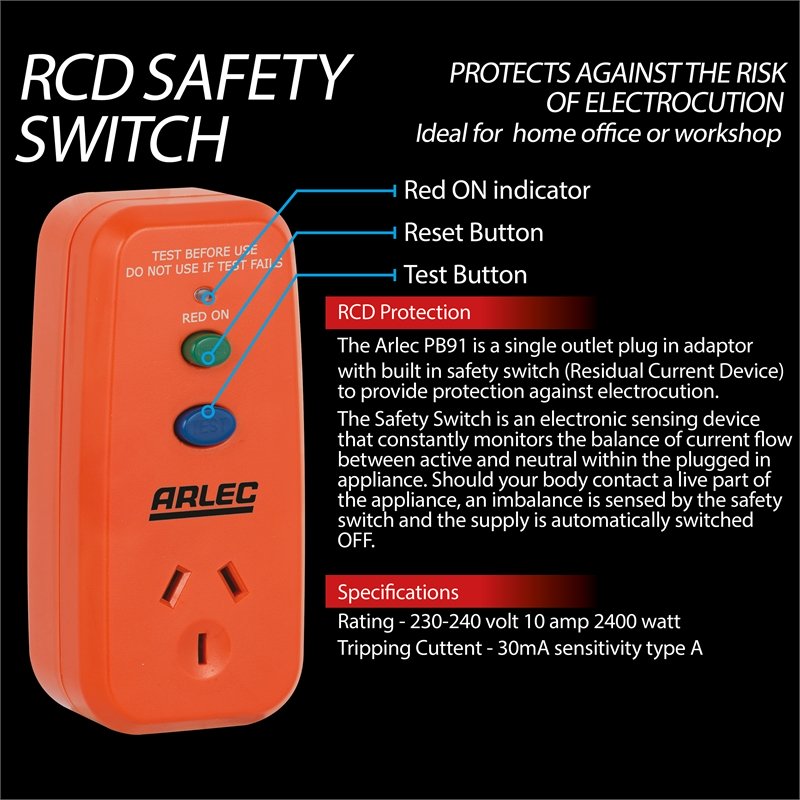The barbecue isn't just a way to cook outdoors. Depending on your skills, tastes, and of course, equipment, it can replicate or even feasibly replace the stove, grill, and oven found inside most people's homes. However, stepping it up a notch, it is also a different cooking style that can go far beyond the capability of your average household kitchen. That said, it can be as simple as you like, or as complex as you want it to be.
Barbecues for socialising and environmental comfort both inside and out:
Many see a barbecue event as a "special" occasion. Set a date, invite a few friends over, have a glass of "something tasty", and chat about anything and everything while delighting in the barbecue experience. However, in our sun-loving country of Australia, it is often more than that. The act of turning on an oven inside on a 41oC degree day (that's 105F in imperial) is unthinkable. So taking the cooking outside for general cooking purposes not only encourages the appreciation of the "great outdoors", but it also saves money on cooling one's home. Some people even forgo the indoor kitchen for days on end entirely and have amazing outdoor kitchens, complete with barbecues, fridges, and entertaining areas.
I don't think this is limited to Australians, but the humble barbecue to some, is truly "a way of life". During my childhood, my family would literally fire our barbecue up (ours was a wood-burning barbecue) and more often than not, our neighbours would see/smell the smoke and in an effort to procrastinate from their daily chores, "pop over" for a chat... which inevitably lead them to inviting the rest of their family, throwing their meat on and bringing some extra salad, dessert, or send one of their kids to "buy something to contribute". It wasn't uncommon in my old neighbourhood to have barbecues at one place or another, between 3 and 7 days a week. We even had one summer, where one of our neighbours were renovating their entire kitchen, so we had barbecues once or twice every day for a couple of weeks. Sometimes, gatherings of the whole neighbourhood and their friends and family would entail over 30 people. I don't mention this to merely reminisce about my "misspent youth", but to point out that inevitably, discussions around the barbecue would centre on the act of barbecuing itself. From these, I learned an important lesson:
Everyone has their own style and opinion on barbecuing... some of it grotesquely misinformed... but try telling them that.
How can one form of cooking have so much controversy and misinformation?
Interestingly, each neighbour had a different style of barbecue, each had their own ways of cooking, and of course, none would agree on the "best" way to cook a barbecue... especially if said neighbour supported a different football team....(which in no way could be the Roosters Vs. Rabbits, you know who you are!) as if that was somehow relevant to barbecuing. Funny how prejudices work, isn't it? When I asked each of them, "who taught you to barbecue?" I'd often get answers like "my dad", "uncle", or "grand dad" or in one case, a neighbour had the most interesting answer that I was not prepared for:
"By an eighth-generation hunter and former chef to King George VI, who I met through my time in the army during World War II using liberated supplies from an enemy encampment that a German platoon had withdrawn from".
Let's process that answer for a moment... (I suppose that's spoils of war.. and so very Aussie to nab anything that isn't nailed down. A decent portion of the First Fleet were convicts sent to Australia for stealing food... nice to see that tradition being upheld... I almost feel proud. However in the years since that moment, I've wondered if "Had withdrawn" meant "we slaughtered them" in a more "child friendly" phrasing).
Each neighbour's respective techniques were akin to "family secrets", both sacred and in everyone's own mind, "the best". However, while "still mooing" or "cremated" appealed to certain individuals.. the ability to cater for different tastes, wasn't always demonstrated. Some insisted on searing the meat first, while others insisted last. Some believed that char was "terrible" while others thought it was "a good sign". Some preferred to cook using a grille, while others preferred a cook plate. Some loved the ease and consistency of a gas powered barbecues while others preferred the smokey flavour imparted by wood or charcoal. There was a whole range of disagreements, (marinade Vs. injection, the best way to tell if the meat is done, even what cooked meats go with which wine/beer...) the list went on and on. This left me confused. As someone would say one thing, then another person would completely and vehemently contradict that. This is a situation which I feel many out there can relate to. Chances are, everyone is both right in some ways, and utterly wrong in others.
There are a lot of misconceptions about cooking on a barbecue. However, before we get to the cooking, let's look at the barbecue types, the strengths, weaknesses, and considerations for each.
Hungry for an outdoorsy delight?
While they're often associated with cooking huge amounts of meat, barbecues can be used in a variety of different ways to cook vegetarian dishes, and even bake cakes or bread. Some designs can be used as smokers and ovens very easily, while others are better at grilling and/or frying. The design and materials used to make barbecues can make a huge difference in capabilities, efficiency and heat retention. Like everything, as a barbecue becomes more capable, the size, weight, and cost goes up. However, no matter which way you go, there's always going to be some form of trade-off.
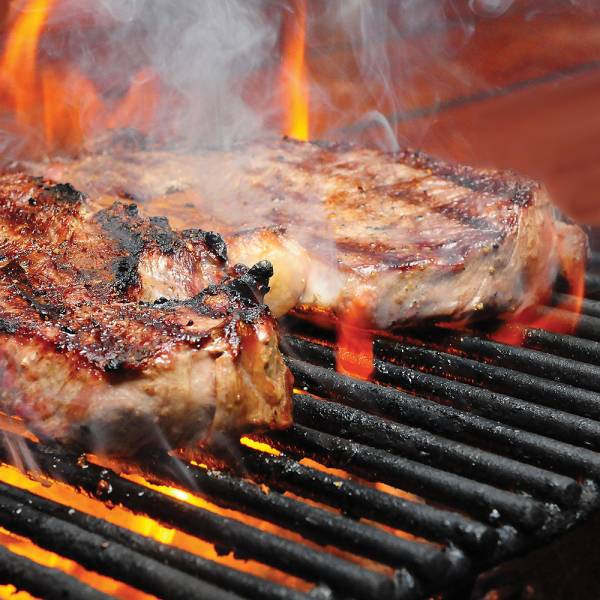
If your flames are licking your meat like this.... you're probably burning the meat. If flames "flare up" due to burning fat, this can quickly overcook, or char your meat in ways that are actually unpleasant. However, in small doses, it will quickly impart a smoky flavour.
Before choosing a barbecue, it might be worth asking: "What would the perfect barbecue entail?"
I'm not talking about having perfect weather, location, company, great food, and general all-round joyous experience, I'm talking about the device itself. To understand the trade offs, it might be worth looking at what the ideals might be, and how one might hinder the attainment of another.
Some of the ideal specifications may entail:
- Makes beautiful food. (Great start, but not exactly specific on how to do that, more specific examples may include...)
- Has enough "cook area" to cook anything you want.
- Can do multiple styles of cooking, often simultaneously. Grill, bake, cold smoke, hot smoke, sear, boil, rotisserie, steam... in short... anything you can think of. It's unlikely you'll do more than two or three at the same time, but being able to reconfigure the barbecue for differing styles of cooking is very handy.
- Easy to use.
- Easy to clean.
- Easy to move.
- Long lasting (nearly indestructible).
- Isn't affected by weather.
- Safe.
- Affordable to buy, and run over time.
- Easy to maintain.
Sounds like a good start, doesn't it.. but there's the less obvious ones that get into the mechanics of cooking like...
- Ideally, a barbecue should have even temperatures throughout the cook area. (No hot or cold spots incinerating/under-coooking your sausages depending on where they're cooked)
- The barbecue be expected to accurately reach and maintain a temperature.
- The ability to quickly heat up and cool down when needed.
- Is incredibly efficient (low use of gas, wood, charcoal, etc), and has the flexibility to use a variety of fuels.
- Can operate at low temperatures (90oC to 110oC) for slow cooking without going out, and do very high temperatures (300oC and beyond) for grilling, and "sanitation by fire".
- Features and accessories to run, and monitor your cook as it progresses. Little things can make your life so much easier.
The problems with choosing a barbecue based on the specifications online/in store.
If you are buying a vehicle, you'll get all sorts of information like the size of the engine, fuel efficiency, how quickly it'll accelerate from stop to a certain speed, towing capacity, boot space, number of doors and seats, power windows, whether it's auto or manual transmission (are true manuals even made anymore?). However, few specs are ever given for barbecue, even ones that are priced similarly to some cars.
You might find it interesting, that it's very rare indeed that any of the ideal specifications mentioned above are provided by most manufacturers, barbecue shops or even professional reviewers.... wait, WHAT?! Have a look at what is usually offered below, this is for a basic 24" Kamado style barbecue:
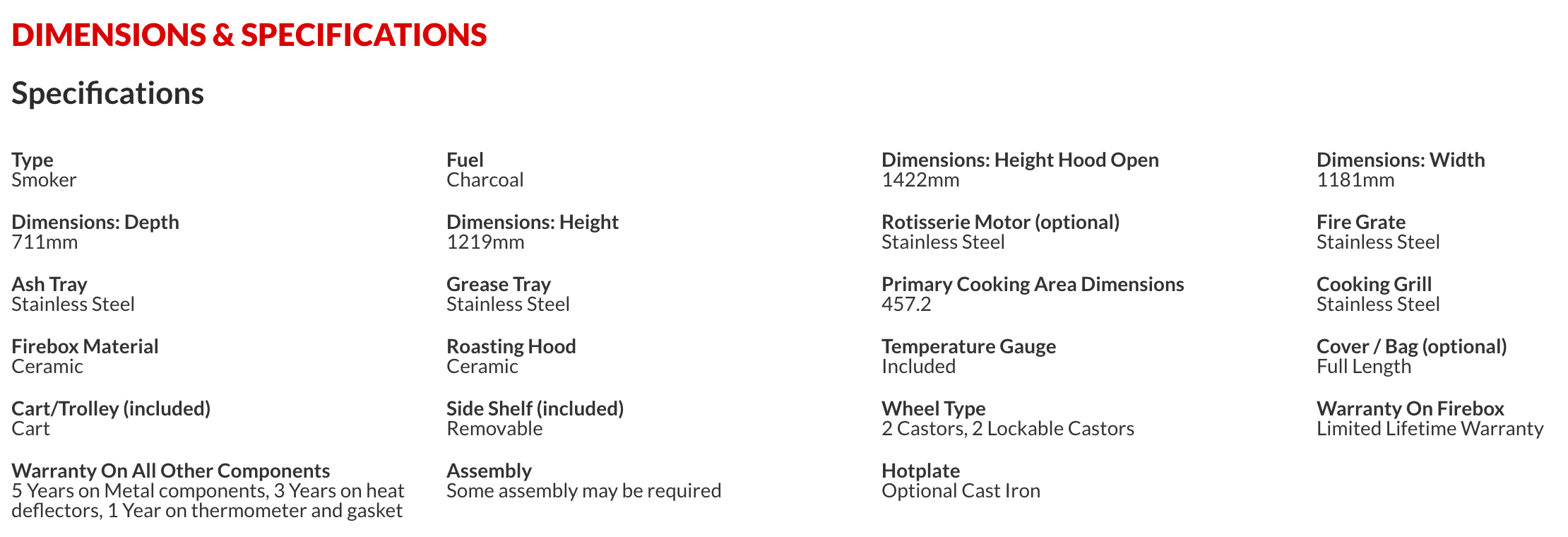
The spec sheet above, provides a wealth of information, but you have to be careful in how you interpret it.
What's in a name?
The sad fact is, that when people are naming things, they don't always give you an accurate picture. For example, this is labelled as a smoker, but it's also a barbecue. Please note, that there are smokers that really aren't barbecues, and barbecues that aren't smokers, but this is a hot-smoking capable barbecue. With optional third-party accessories, you can add cold-smoking to the feature list too.
Adding fuel to the fire:
The fuel type is charcoal, but if you look at the firebox and hood material, (ceramic) you might want to hold off from using any petroleum-based fire starters (particularly kerosene, any sort of petrol) as it will impregnate the porous ceramics with a foul-smelling and worse-tasting residue that will impact the flavour of anything cooked on that barbecue... perhaps for a very long time. Charcoal doesn't really tell us much, as some smokers will use moulded charcoal briquettes, some people swear by lump charcoal, and other people won't realise that it's also possible to use firewood either in addition to the charcoal, or even as a replacement in a pinch.
Dimensional dramas:
The dimensions are a particularly troublesome spec to truly understand. You see, the cooking area states that it's 457.2 (with no units) and after some number crunching, I believe this is in square inches. (They clearly copied and pasted from the American manufacturer's site). If you care, 457.2 square inches is 2949.6715 cm2. (Or imagine a circle that has a diameter of 61cm, or 24 inches.). The width says 1181mm, but that actually includes the fold-out shelves on either side (but not explained), and the depth, includes the hinge that protrudes on the back... but does not mention what happens to the domed lid when it's tipped up and back. So don't assume that you'll get anywhere near the cook area imagined by the width and depth. Also, have a really good look at the device in person so you know what it's like.
Look at the parts with the shortest warranty:
The temperature gauge and gasket (the seal between the lid and body of the kamado).... you'll note that it has only a 1 year warranty. In honesty.. the temperature gauge that came with my kamado had a miserly 30 day warranty, which indicates how much faith the manufacturer had in it. Many of the included gauges are inaccurate, so I highly recommend that you get a good thermometer.
Materials matter:
Stainless steel grills, fire grate, and ash tray indicate a hard wearing, rust resistant (remember that's stain-less, not stain-free) and easy to clean surface. However, note that you only get iron in the optional hot plate. Iron is prone to rust, but has some amazing conductive properties and if looked after properly can do some really nice grilling and frying.
Meanwhile the ceramic construction of the Kamado, will mean that there is a lot of material that needs to be heated up. That amount of thermal mass needs to be managed carefully. This will mean slower heat up and cool down, but also more even temperatures throughout the cooking area as well as over time. Also, the heat retention of the ceramics means that cooking can go for hours after the fire has died down. However, if you overheat your barbecue it can take hours to bring it back down again. You cannot cool the unit down rapidly as this will crack the ceramic material. Ironically, by opening the lid, the fire gets more oxygen, so this can actually increase temperatures, rather than cooling the barbecue down for cooking.
Of course, another down side is that ceramics are very delicate. If they fall over, they'll break, they're incredibly heavy, and aren't very portable. Never pour water on a hot ceramic barbecue or it will simply crack, or even shatter. Simply close the lid, and seal the vents to put the flames out... or slow the burn rate.
The metal hinges, and bands attaching the hinge to the ceramic parts need to be regularly checked. The constant heating up and cooling down can make screws and bolts loosen, and the metal needs to be checked for rust and other problems as well. If it does rust, clean it off with a little WD40 and a wire brush, then re-coat with a high temperature paint.
So with these ideas in mind, let's do a brief history of the humble barbecue, and compare differing fuels, materials, and styles so you can figure out what works for you.
How long have barbecues been around?
It might surprise you that barbecues have been around a lot longer than most people think. Some forms, such as the Kamado (or "Earth oven" in Japanese ) which is basically a ceramic version of the popular Weber Kettle barbecue, has actually been around for thousands of years in one form or another. Metal pots have been placed over camp fires for centuries, and let's not forget the spit roast/rotisserie, which have cooked many forms of game over a fire for centuries. However, it has only been in the last century or so, that the barbecue has become the iconic cooking method that we see today.
The origins of the Earth ovens, go so far back, there's a lot lost to history. However, if you're interested in more modern barbecues, there's an article on the inception of the "Weber" barbecue, and it can be found here:
https://www.smithsonianmag.com/innovation/story-weber-grill-begins-buoy-180960335/
Barbecue Fuels:
No matter what the type, barbecues are defined as much by their fuel as design and materials. Barbecues are typically heated using gas, wood, coal, charcoal, electricity or even just concentrated solar light. (Although charcoal and gas are the most common types). Each fuel type can bring with it certain benefits, and potential problems.
Gas:
Gas usually comes in the form of "liquefied petroleum gas"/"liquefied propane gas" (or LPG) which is usually what you find in your average barbecue gas cylinder. For campers, you might have an aerosol can full of butane (lighter fluid). For people with natural gas at home, some people use the main gas line to fuel the barbecue. Which means you never run out of gas, and never have to swap out a cylinder in the middle of a cooking session. There's not much difference in the taste of the food using one type of gas over another, and most gas barbecues have the advantage of being legally usable during a total fire ban. It's also easy to clean as there's little-to-no ash generated. However, because it's a "clean burning" fuel, you're not going to get much of a smokey flavour using the barbecue "as is". (Don't worry, I'll discuss adding that later).
Gas also has the advantage of being very easy to start, and it rarely takes long to heat the barbecue up and more importantly cool down. The down sides to gas is that you need to maintain your cyclinder, regulator, and gas lines very well in order to maintain safe operation of the barbecue. If you're not using the barbecue for a long time, gas can leak, and pose a significant safety hazard, especially in confined spaces. Explosions are real possibility with gas barbecues, and it might be caused by something as simple as the flame being blown out.
Gas burners might not be "universally compatible" with each type of gas. Gas barbecues may need to be converted if you're switching from LPG to natural gas or vice versa. Converting it may be a simple process of just drilling larger holes in the burners, but in many cases it's just cheaper and easier to buy a new burner, or even new barbecue (whether that's new or for an absolute bargain on Gumtree or other second hand market, is up to you... just make sure you inspect the barbecue thoroughly before buying).
Smoking is possible on lidded gas burners, usually by placing wood chips in a metal container and sitting it on/near the burners. However gas barbecues are designed to minimize the risk of explosions by having numerous holes to allow gas to escape. This means you need to burn more wood chips to make up for the smoke that escapes so readily, and perhaps moisten/marinade your foods to increase smoke adhesion to your food, or that you need to strategically place your cooking food where the smoke is most dense to get an adequate smoke flavour.
Please note: Some gases are denser than air, and as such, can pool in the bottom of a barbecue. Other gases act much like air, and others escape readily. Please read the safety instructions for your particular barbecue.
Solid fuels:
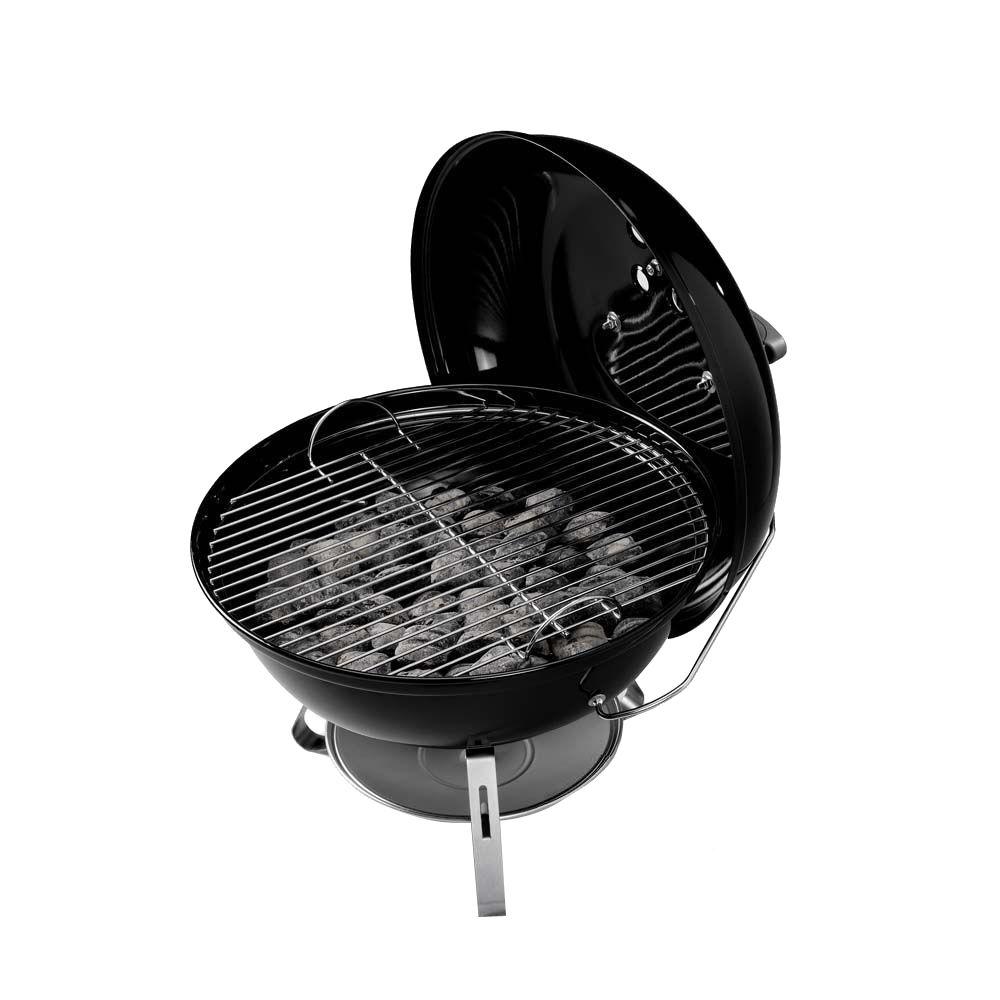
In general, most solid fueled barbecues (wood, coal and charcoal) offer a smoky flavour that some will absolutely love, and others hate. It's important that you get the solid fuel types right for your barbecue because it's possible to create really unpleasant flavours, and even poison people if you get it wrong. So let's start with wood.
Wood:
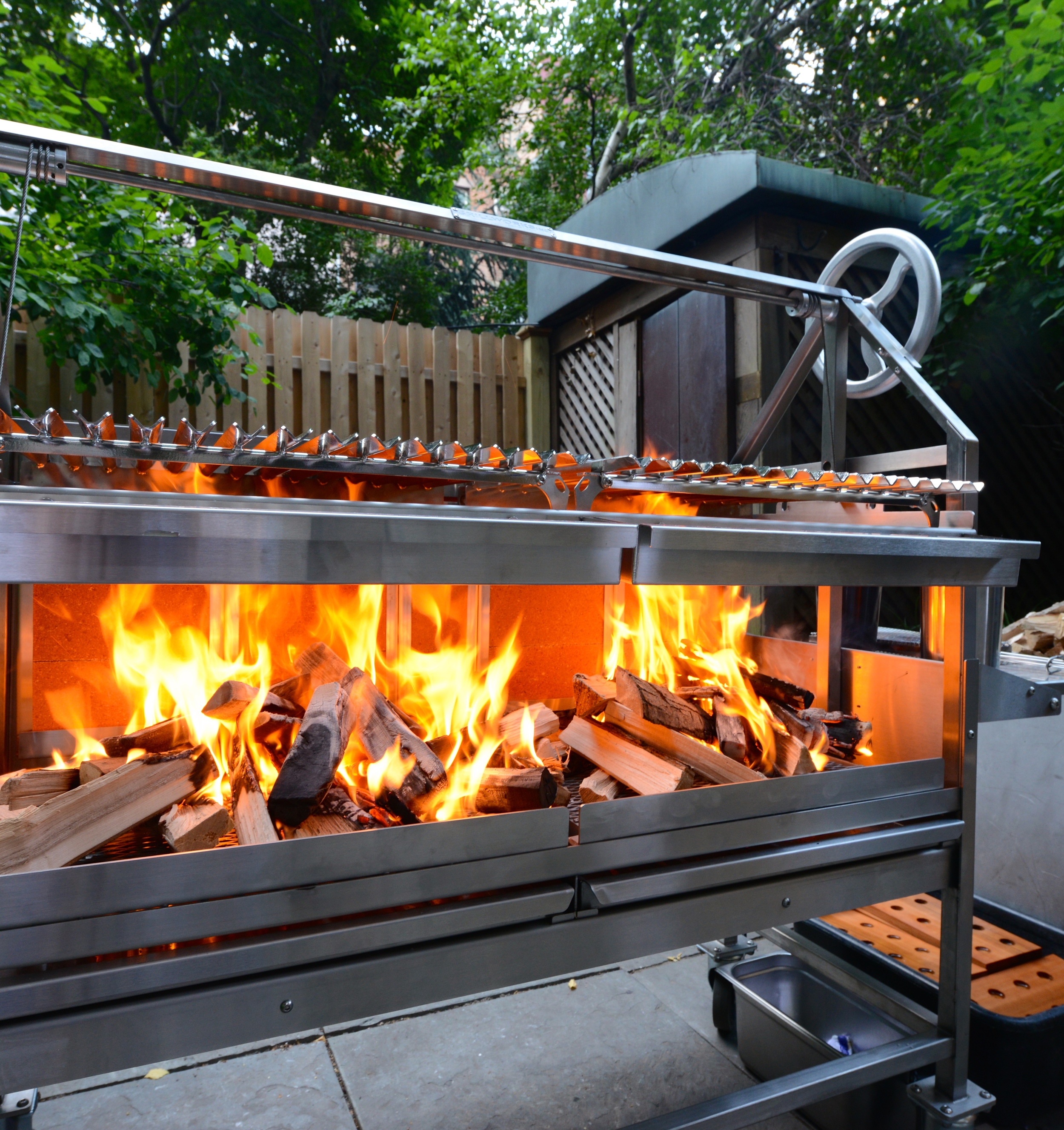
Wood, if being used to cook food must be natural wood. You do NOT want to use treated woods as they contain arsenic, painted woods (who knows what they release when burned), or laminated woods (burned glue/varnish is not tasty or safe). Also, some woods like certain varieties of pine can leave resin residue that can make things taste awful. So be careful about what you choose to burn. Remember: a barbecue is not a bonfire or incinerator!
Coal:
Coal is the fossilized vegetable matter that powered the industrial revolution, and still runs a range of things from steam trains to power stations. There are some people who run "coal fired pizza places". Personally, I am not a huge fan of black/brown coal as it can be way too smoky and often leaves unburned coal dots and burned soot all over your food. I find that I don't enjoy the flavour anywhere near as much as charcoal. However, you might like it more than I do.
Charcoal:
Natural charcoal is "partially burned wood". However, many places sell "charcoal briquettes" which are made up of small chunks/powdered charcoal that are actually bound together into consistent shapes. Briquettes do have the advantage of being equally sized, so the rate of burn and the consistency of heat output is much easier to predict and consequently, maintain desired temperatures.... with practice. However, while many briquette manufacturers use natural binding agents to make up the briquettes.... a few use chemical binding agents that really aren't suited to porous material-based barbecues. (Brick, concrete, or ceramic barbecues). However, they'd be fine in metal barbecues. So read the packet carefully before choosing briquettes.
If you're in doubt, from a safety perspective, you're far better off using "lump" or "natural" charcoal which is literally partially burned branches as it's a far more natural product. You can usually find lump charcoal in your local hardware store. Buying the premium stuff (usually in boxes) has advantages in that the pieces are bigger, which increases airflow and offers a cleaner burn. The bags of charcoal are often cheaper, but the pieces are often smaller (perhaps because they were broken in the bag during transit) which can be more difficult to get started because the smaller pieces fit together more tightly, and reduce the airflow around them when burning.
Charcoal, especially lump charcoal, can be a little hard to predict. Some pieces will burn faster than others, so the heat and burn rate is not necessarily even. However, the biggest negatives to charcoal is that it can be quite challenging to get started, and a little fiddly to get things to stay at a consistent temperature. Also, it can leave a lot of ash behind, go out suddenly, and can occasionally spit a ton of sparks out.. which might be fire hazard. Perhaps most insidious of all, is that burning charcoal releases carbon monoxide. Never cook a charcoal barbecue in a shed, or other confined space. You must have a great deal of airflow.
For porous barbecues (ceramic/concrete/brick), do NOT use lighter fluid or kerosene-based fire starters (the white waxy kind many people start their wood heaters with), as those too can leave chemicals that embed themselves into the pores of the barbecue and affect the flavour of the food long after you've done it only once. I highly recommend the "natural" fire lighters, usually some form of kindling, paper, or compressed paper. I use these in conjunction with a "starter chimney" or "chimney" (which is basically a metal can with a lot of holes on the bottom, sides and open top. With a suitable fire lighter underneath, set fire to it, and fill the chimney with charcoal. The fire burns it from the bottom up and gets a lot of coals burning within 10-20 minutes. Here's a YouTube video I have found for your convenience:
Alternatively use an electric barbecue starter, with chimney or directly to the coals in the barbecue. Here's yet another video:
If you have a charcoal barbecue, particularly those with lids, remember to open up the bottom AND top air vents to get it going, then partially close the bottom vent to control the temperature once your more than half way to your desired temperature to avoid "overshooting" target temperature. If you're just beginning, I recommend that you leave the top vents "wide open" throughout your entire cook as this will keep the smoky flavour to modest levels. This gets to be even more important for longer cooks with larger chunks of marinaded meat. If the smoke has very blue tinge to it, this is a sign that your coals aren't burning properly yet, and so you don't want to put the food in until the smoke is closer to a light blue, or white. A little blue tinge of wispy smoke is perfectly fine. Small amounts of smoke indicates that you're getting a clean burn and your barbecue is ready to start cooking.
Now I'll talk about barbecue materials in the next section. However, for people using metal barbecues, you can probably light up 10-20 minutes before you need to start cooking. However, for ceramic, earth, brick, or concrete barbecues, it's going to take longer to get to this point. If you have a kamado, you often have to start the fire 40mins to an hour or so before cooking. Full blown brick, large scale earth ovens.. will take even longer to heat up because the material needs a lot of energy to heat up. So keep that in mind.
Electricity:
Arguably the easiest to manage in most powered situations. They're very safe as they're unlikely to start a fire. They're very easy to start, stop, and there's very little ash. You can use electric barbecues in somewhat confined spaces as there is little smoke, or carbon monoxide/dioxide. In fact, it's really quite similar to an electric fry pan, or electric grill and has many benefits. However, like every fuel, there's a few down sides, like the lack of smoke can impact flavour choices. Being effectively a heating element usually embedded within/underneath a hot plate it can be difficult to get that "true" radiant-fire grilling experience. Which if you know what you're doing, you can still get a respectable result.. but if barbecuing is your goal, then you're probably better off considering an alternative barbecue suited to a different type of fuel.
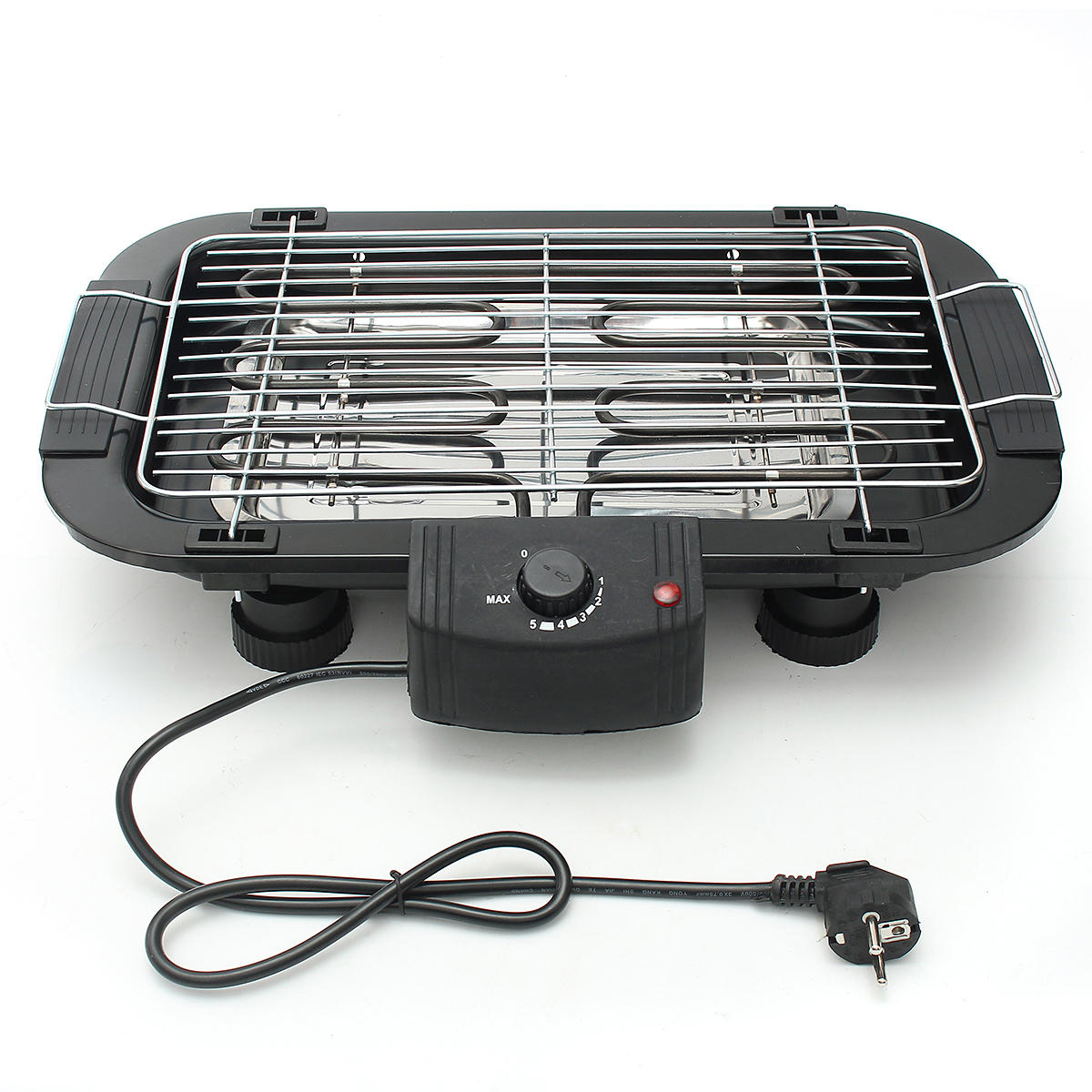
Perhaps the biggest problem is the reliance on (usually) mains power to heat up. If you're going traveling around the bush, then this is less likely to be the best option.. but you'll find that many camp grounds, parks, and caravan parks either have permanently placed electric barbecues, or power sources capable of supplying the power you need.
Electric barbecues are usually power-hungry appliances. Often starting at 1000W and may even go up to 2400W in Australia. Also, electrical safety is an important consideration. I'd make sure that your power cords are of a heavier-duty, and higher amperage variety, and I strongly encourage the use of a dedicated "Safety switch" which will cut the power should there be a problem. Note that most power boards only trip their breakers during a power spike, and not necessarily when a fault or electrical hazard has occurred.
Solar barbecues:
While these are an unusual barbecue. These can come in a variety of styles and range from foil covered cardboard to parabolic mirrors, and some involve a simple dark-coloured metal plate left in the summer sun. They're often used as educational kid-friendly projects, but some have been professionally designed and built like the one below.
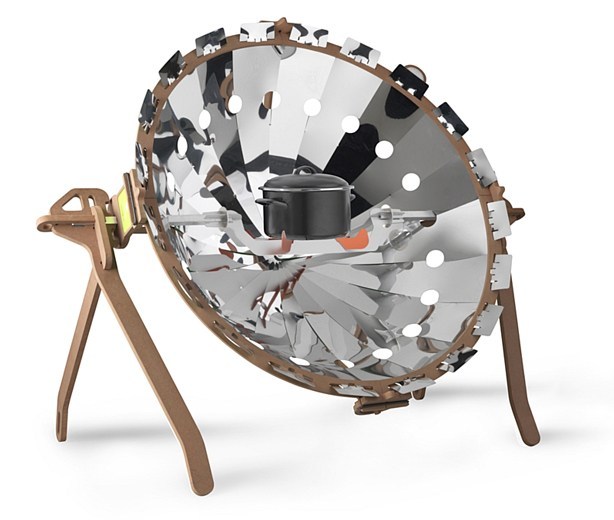
The biggest issue with solar is of course, that they're usually fiddly to setup, are reliant on a good amount of sun, and obviously don't work at night. Another complaint is that the whole unit must be re-oriented as the sun moves. Temperature control is also an issue, as clouds, and partial mis-alignments can substantially reduce the heat applied to the food.
An unusual issue with solar barbecues occurs due to wind. I've read user experiences outlining the fact that they're prone to being knocked over in strong wind, as the reflectors often form a large sail area. However, if you don't mind these issues, they're completely free to run, and work well in the hot-dry areas that form most of Australia. If you're going to spend long periods of time standing near this thing in an Aussie summer, you're going to need sunglasses and sunscreen. So I'd strongly urge you to cook things that don't necessarily need to be constantly managed. I have boiled water in my university physics practical sessions using a much more rudimentary setup than the one above, but I'm not convinced it has the fine temperature control required for some forms of barbecuing.
Stay tuned for the next article. Barbecue 2: Ceramic, metal, brick, and earth.
